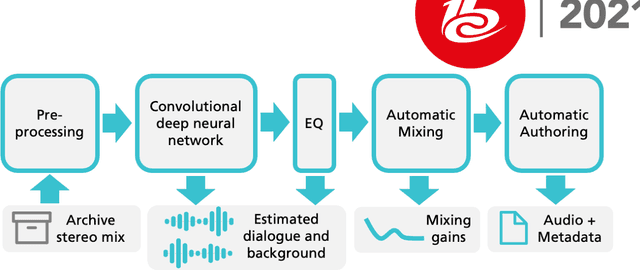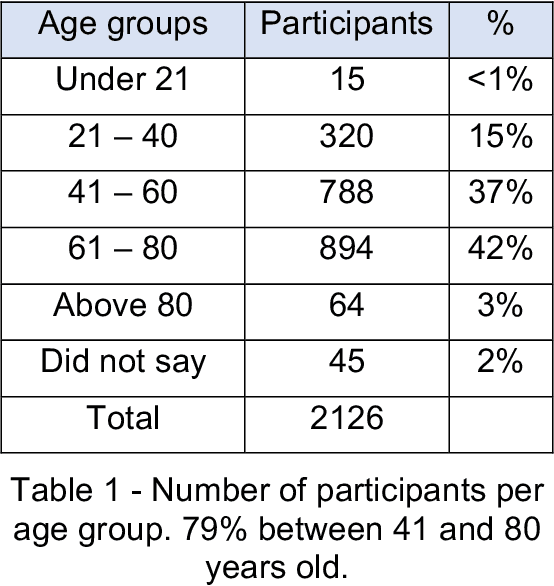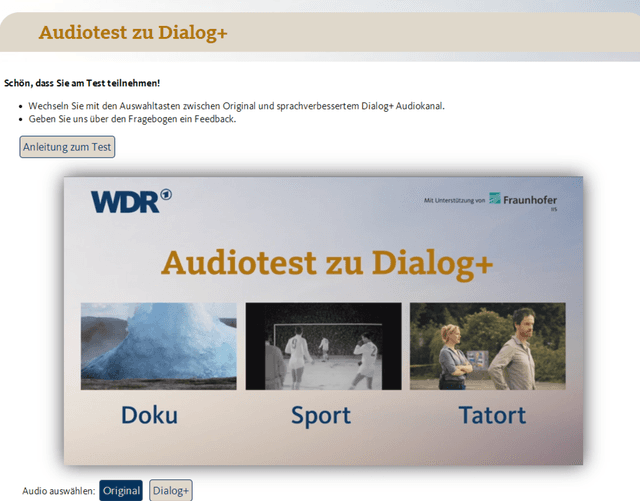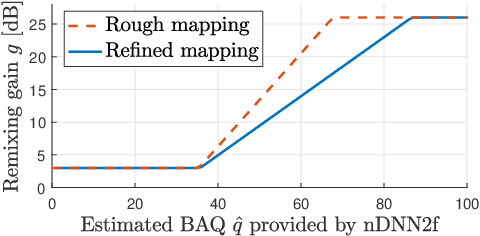Christian Uhle
Dialog+ in Broadcasting: First Field Tests Using Deep-Learning-Based Dialogue Enhancement
Dec 17, 2021



Abstract:Difficulties in following speech due to loud background sounds are common in broadcasting. Object-based audio, e.g., MPEG-H Audio solves this problem by providing a user-adjustable speech level. While object-based audio is gaining momentum, transitioning to it requires time and effort. Also, lots of content exists, produced and archived outside the object-based workflows. To address this, Fraunhofer IIS has developed a deep-learning solution called Dialog+, capable of enabling speech level personalization also for content with only the final audio tracks available. This paper reports on public field tests evaluating Dialog+, conducted together with Westdeutscher Rundfunk (WDR) and Bayerischer Rundfunk (BR), starting from September 2020. To our knowledge, these are the first large-scale tests of this kind. As part of one of these, a survey with more than 2,000 participants showed that 90% of the people above 60 years old have problems in understanding speech in TV "often" or "very often". Overall, 83% of the participants liked the possibility to switch to Dialog+, including those who do not normally struggle with speech intelligibility. Dialog+ introduces a clear benefit for the audience, filling the gap between object-based broadcasting and traditionally produced material.
Controlling the Perceived Sound Quality for Dialogue Enhancement with Deep Learning
Jul 22, 2021



Abstract:Speech enhancement attenuates interfering sounds in speech signals but may introduce artifacts that perceivably deteriorate the output signal. We propose a method for controlling the trade-off between the attenuation of the interfering background signal and the loss of sound quality. A deep neural network estimates the attenuation of the separated background signal such that the sound quality, quantified using the Artifact-related Perceptual Score, meets an adjustable target. Subjective evaluations indicate that consistent sound quality is obtained across various input signals. Our experiments show that the proposed method is able to control the trade-off with an accuracy that is adequate for real-world dialogue enhancement applications.
* Accepted paper at ICASSP 2020
Controlling the Remixing of Separated Dialogue with a Non-Intrusive Quality Estimate
Jul 21, 2021



Abstract:Remixing separated audio sources trades off interferer attenuation against the amount of audible deteriorations. This paper proposes a non-intrusive audio quality estimation method for controlling this trade-off in a signal-adaptive manner. The recently proposed 2f-model is adopted as the underlying quality measure, since it has been shown to correlate strongly with basic audio quality in source separation. An alternative operation mode of the measure is proposed, more appropriate when considering material with long inactive periods of the target source. The 2f-model requires the reference target source as an input, but this is not available in many applications. Deep neural networks (DNNs) are trained to estimate the 2f-model intrusively using the reference target (iDNN2f), non-intrusively using the input mix as reference (nDNN2f), and reference-free using only the separated output signal (rDNN2f). It is shown that iDNN2f achieves very strong correlation with the original measure on the test data (Pearson r=0.99), while performance decreases for nDNN2f (r>=0.91) and rDNN2f (r>=0.82). The non-intrusive estimate nDNN2f is mapped to select item-dependent remixing gains with the aim of maximizing the interferer attenuation under a constraint on the minimum quality of the remixed output (e.g., audible but not annoying deteriorations). A listening test shows that this is successfully achieved even with very different selected gains (up to 23 dB difference).
 Add to Chrome
Add to Chrome Add to Firefox
Add to Firefox Add to Edge
Add to Edge